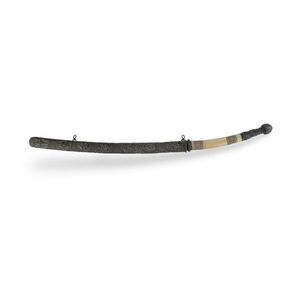Burmese Silver and Ivory Mounted Dha Sword with Provenance
Fine quality Burmese silver and ivory mounted Dha sword. With hand-forged single edged curved blade. The ivory hilt carved with two bands of scrolling foliage. Wooden scabbard encased in silver repousse decorated with dancing figures. Nb: ivory export restrictions. Length 109 cm (in scabbard). Provenance: Estates late Adolphe and Asra Alexander, a German-Thai couple involved with architecture, interior design and import-export merchant trading, initially operating in Bangkok they moved to Brisbane in 1960. Asra was the daughter of a German merchant living in Thailand whose Company imported luxury European goods, and (with Royal warrant) counted the Thai palace among their customers. Thence by descent - private collection, Canberra.
You must be a subscriber, and be logged in to view price and dealer details.
Subscribe Now to view actual auction price for this item
When you subscribe, you have the option of setting the currency in which to display prices to $Au, $US, $NZ or Stg.
This item has been sold, and the description, image and price are for reference purposes only.
- Ivory - Ivory is a hard white material that comes from the tusks of elephants, mammoth, walrus and boar, or from the teeth of hippopotamus and whales. The ivory from the African elephant is the most prized source of ivory. Although the mammoth is extinct, tusks are still being unearthed in Russia and offered for sale.
Ivory has been used since the earliest times as a material for sculpture of small items, both in Europe and the east, principally China and Japan.
In Asia ivory has been carved for netsuke, seals, okimono, card cases, fan supports, animals and other figures and even as carved tusks.
In the last 200 years in Europe ivory has been used to carve figures, for elaborate tankards, snuff boxes, cane handles, embroidery and sewing accessories, in jewellery and as inlay on furniture. Its more practical uses include being used for billiard balls, buttons, and a veneers on the top of piano keys.
The use and trade of elephant ivory have become controversial because they have contributed to Due to the decline in elephant populations because of the trade in ivory, the Asian elephant was placed on Appendix One of the Convention on International Trade in Endangered Species (CITES), in 1975, and in January 1990, the African elephant was similarly listed. Under Appendix One, international trade in Asian or African elephant ivory between member countries is forbidden. Unlike trade in elephant tusks, trade in mammoth tusks is legal.
Since the invention of plastics, there have been many attempts to create an artificial ivory - Embossed / Repousse - Embossing, also known as repousse, is the technique of decorating metal with raised designs, by pressing or beating out the design from the reverse side of the object.It is the opposite of chasing, where the decoration is applied from the front. An embossed or repoussed object may have chasing applied to finish off the design.
This item has been included into following indexes:
- Chinese silver - export ware 315
-
silver, country of manufacture
- Burmese, Shan 174
- Siamese, Thai 168
